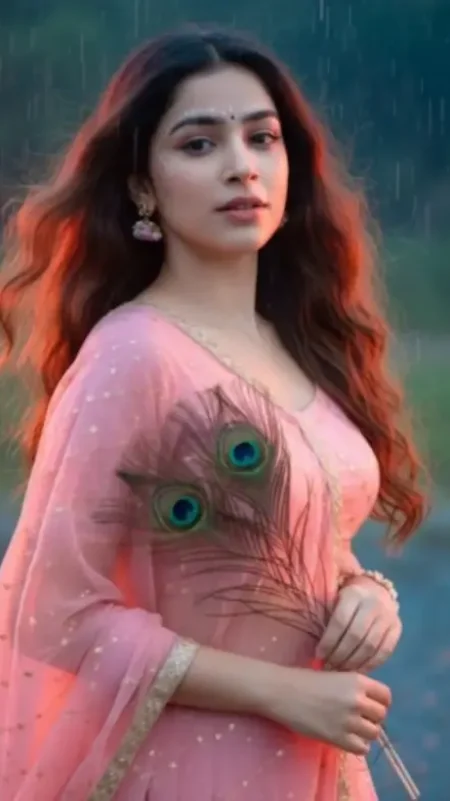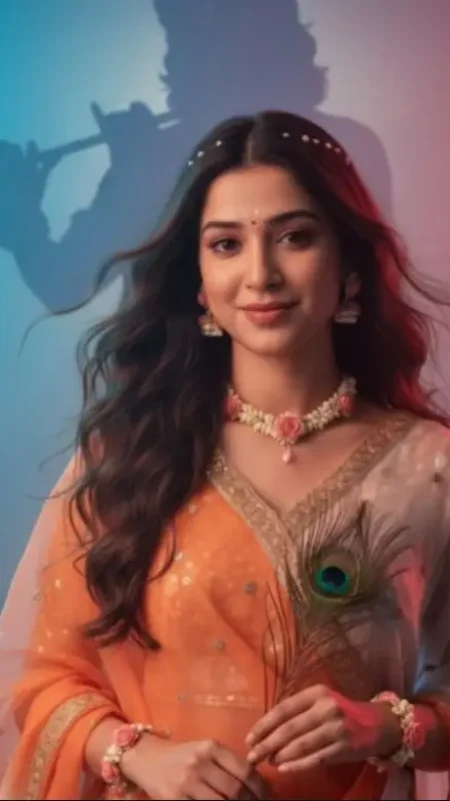



Introduction
There’s something timeless and magical about the Radha saree aesthetic — the flowing drape of fabric, the soft glow of gold embroidery, the cultural lore that breathes life into portraits. If you’ve been experimenting with Gemini or AI image generation tools, creating a Radha-inspired portrait can be both inspiring and challenging. How do you balance divine aura with realism? How do you choose fabrics, jewelry, lighting, and environment so the image looks authentic rather than staged? In this post we’ll walk through what makes Radha saree prompts work, share several examples to spark your creativity, and give you tips to perfect your prompt so the output feels gentle, divine, and beautiful.
What makes the Radha look special
The Radha figure in Indian art is associated with devotion, beauty, romance, nature, and ornamentation. Portraits of Radha often include floral jewelry, peacock motifs, soft sarees, expressive eyes, graceful posture, and a sense of serenity. Translating that into AI prompts means including styling details (flower garlands, peacock feathers), color palettes (gold, peach-pink, soft pastels), lighting that feels divine (soft gradient sky, warm glow), and elements that evoke myth and story without overwhelming the portrait.
Understanding the example prompts
GadgetPouch’s “Radha Saree Prompts for Realistic AI Portraits” page gives several excellent starting examples. Each prompt begins with “Use the face from the uploaded photo exactly as it is” — that’s important for preserving identity or likeness. Then it layers in styling: saree color and transparency (peach-pink transparent, white with golden embroidery, orange with gold, etc.), jewelry (floral jewelry, maang tikka, bangles), hair style (long wavy, open), accessories like peacock feathers, subtle retouching, soft natural lighting, and expression. Backgrounds vary: gradient walls with blue or pink lighting, silhouette shadows of Krishna, outdoor greenery with rain. These variations show how small differences (background, lighting, pose) can shift mood dramatically.
How to build your own Radha saree prompt
You can adapt these examples to match your vision. Here’s a process to follow when you write your own prompt:
1. Face & identity preservation
If you upload a photo with a face you want to preserve, tell Gemini to use it exactly as it is. That anchors the likeness — eyes, facial structure, expression. Then add instructions like “subtle retouching” rather than “beauty filter” to avoid over-editing.
2. Saree style and color
Choose the saree fabric, drape style (pleated, flowing, transparent), color palette. Peach-pink, white, orange, pastel shades with golden embroidery work beautifully. If you want transparency, mention “transparent saree draped gracefully.” Embroidery details — border, pattern, golden threads — add richness. Also name the blouse: color, whether it’s embroidered or plain.
3. Jewelry & adornments
Think floral jewelry sets, peacock feathers, bangles, maang tikka, earrings, maybe nose ring if appropriate. Hair accessories like flowers or peacock feathers give a mythical touch. Subtle forehead designs or dotted motifs help evoke traditional symbolism. But balance is key: too many accessories can distract; choose a few that express your theme.
4. Hair style & makeup
Long, wavy open hair is common; loose curls or soft waves. You could add natural makeup, glowing skin, minimal lipstick, emphasis on the eyes with gentle highlight. Words like “soft glowing skin” or “enhance the eyes gently” work better than “heavy makeup” if you want subtle beauty rather than glam-pageant style. If you want a bindi or forehead design, specify its color, size, shape.
5. Setting & background elements
Background choices give context and mood. Gradient walls (blue-orange, pink-blue), silhouettes of mythological figures (Krishna playing flute), outdoor greenery with rain, golden hour light — each adds atmosphere. Include whether background should be blurred (bokeh) or have sharp elements. If you want divine aura, mention light rays, shadows, soft halos or glow. Balance between subject and background — the subject should remain the focus.
6. Lighting & mood
Light direction, softness, color, glow are essential. Soft natural light, diffused glow, subtle rim lighting, warm tones. If using gradient lighting or colored ambient light, describe exactly how you want blue, orange, or pink tones to interact. “Soft gradient blue and orange lighting” gives more guidance than “colorful lighting.” Mood can shift by changing lighting: twilight warmth vs divine glow vs natural daylight.
7. Pose, expression & storytelling
Pose should be graceful and calm. A gentle smile works well. Maybe she holds peacock feathers, or floral garlands, or stands mid-shot (waist up). Expression should convey serenity, divinity, or softness. Not rigid or stiff. If holding something (floral baubles or garlands), mention how: “holding floral bangles and garlands gently.” These props add story and hands add naturalness.
8. Detail & finishing style
Specify “cinematic photography,” “divine aura,” “mid-shot portrait,” “realistic skin texture,” “soft glowing skin,” etc. If possible, mention resolution or focus (“sharp focus on eyes,” “portrait photography style”). Subtle retouching language like “enhance eyes and lips gently” helps preserve realism. Avoid commands that override identity, unless you want stylization.\
Prompt examples inspired by GadgetPouch Radha series
Here are a few prompts you can copy, adapt, or combine:
“Use the face from the uploaded photo exactly as it is. Subtle retouching for clear and smooth skin. Portrait of a beautiful Indian woman styled as Radha, wearing a yellow embroidered blouse with a peach-pink transparent saree draped gracefully. Long wavy open hair, floral jewelry in yellow and white, bindi on forehead, soft glowing skin. A peacock feather tucked in her hair. Background shows the divine shadow silhouette of Lord Krishna playing flute, with soft gradient blue and orange lighting. She stands with a gentle smile, holding floral bangles and garlands, cinematic divine aura.”
“Use the face from the uploaded photo exactly as it is. Subtle retouching, natural lighting. Portrait of elegant woman styled as Radha, wearing a white saree with golden embroidery, paired with blue floral jewelry. Long wavy flowing hair, minimal makeup, bindi on forehead. Holding three peacock feathers close to chest. Background plain gradient wall with blue-pink lighting. Mid-shot portrait, divine aura, cinematic style.”
“Use the face from the uploaded photo exactly as it is. Subtle retouching, outdoor setting with rainy atmosphere. Radha-inspired portrait in peach-pink saree with golden embroidery. Long flowing wavy hair, floral earrings, soft glowing makeup, white dotted forehead design. Holding peacock feathers. The background outdoors with greenery, rain softly falling, warm lighting highlighting her face. Calm yet divine expression, cinematic photography.”
Common pitfalls & how to fix them
Sometimes the first output isn’t perfect. If eyes look unnatural, add “correct eye shape, enhance catch light in eyes.” If saree embroidery is missing, say “increase embroidery detail.” If background distracts, ask for “background blur” or “less contrast behind subject.” If skin looks too smooth or plastic, specify “natural texture, avoid over-smoothing.” Be ready to iterate.
Balancing realism with divine styling
If you push for “divine aura” or “mythical feel,” there’s risk of making it look over-styled or fake. Keep realism in identity (face, skin tones, proportions). Use subtle props and lighting rather than heavy filters. Choose accessories that match traditional styles genuinely, rather than fantasy versions. Use cultural symbols sensitively — peacock feather, flowers, jewelry — but avoid clichés if they don’t fit the story you want to tell.
Why these portraits connect
People respond to images that feel both familiar and elevated. A Radha portrait taps into cultural symbolism, romance, aesthetics, mythology. When done right, it evokes beauty, serenity, and a story without needing words. That leads to deeper engagement — viewers linger. They share because it feels meaningful. On a site like GadgetPouch, which bridges tech and creativity, combining AI prompt craft with cultural portraiture creates a niche: tech users who care about art, identity, and aesthetics.
Final thoughts & next steps
Creating realistic Radha saree portraits with AI is a blend of cultural respect, stylistic detail, and iterative refinement. Start with clear identity, layer on saree, jewelry, lighting, background, and expression. Use the example prompts above, tweak them for your style. When you get a first decent result, refine until small details like embroidery, eye sparkle, skin texture are satisfying. If you want, I can create 5 more Radha-inspired prompt packs (ready-to-use) that fit different moods — day, night, festival, intimate portrait, divine aura. Would you like me to send those?
